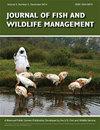Estimating Age and Growth of Largemouth Bass in Southwestern Reservoirs Using Otoliths and Scales
IF 0.9
4区 环境科学与生态学
Q4 BIODIVERSITY CONSERVATION
引用次数: 0
Abstract
Age and growth data are frequently used to monitor and manage important North American sport fishes like Largemouth Bass Micropterus salmoides. Continental and regional growth standards have been developed for the species to assess fish growth over time and across space. However, Largemouth Bass age and growth data are infrequently collected in Arizona and the reliability of age estimates derived from typical structures (e.g., scales, otoliths) in the Southwest is uncertain. Our objectives were to 1) compare precision and bias of age estimates from scales with those from otoliths and 2) estimate Largemouth Bass growth in several southwestern warmwater reservoirs using otoliths. We collected Largemouth Bass from three Arizona reservoirs (Alamo, Peña Blanca, and Roosevelt) using boat electrofishing in spring 2021. Scales and sagittal otoliths were removed from fish, prepared, and independently aged three times. Differences in precision and bias between scales and otoliths were compared using reader agreement percentages, confidence ratings, average coefficient of variation, and age-bias plots. We used age estimates from Largemouth Bass otoliths to calculate mean lengths-at-age at capture and relative growth indices based on published growth standards in each reservoir. Largemouth Bass scale age estimates were less precise, overestimated ages of younger fish, and underestimated age of older fish compared to otoliths. Growth was lower in Peña Blanca Lake than in the other two reservoirs according to mean length-at-age estimates, and relative growth indices suggested that Largemouth Bass growth in all three reservoirs was above average at younger ages, but less so at older ages. The results from this study add to a growing body of literature supporting the use of otoliths for estimating age and growth of Largemouth Bass.利用耳石和尺度估算西南水库Largemouth Bass的年龄和生长
年龄和生长数据经常用于监测和管理重要的北美运动鱼类,如Largemouth Bass Microterus salmoides。已经为该物种制定了大陆和区域生长标准,以评估鱼类在时间和空间上的生长情况。然而,亚利桑那州很少收集Largemouth Bass的年龄和生长数据,西南部典型结构(如鳞片、耳石)得出的年龄估计的可靠性也不确定。我们的目标是:1)比较规模和耳石年龄估计的准确性和偏差;2)使用耳石估计西南部几个暖水储层中Largemouth Bass的生长。2021年春季,我们使用船电捕鱼从亚利桑那州的三个水库(阿拉莫、佩尼亚布兰卡和罗斯福)收集了Largemouth Bass。从鱼身上取下鳞片和矢状耳石,制备并独立老化三次。使用读者一致性百分比、置信度、平均变异系数和年龄偏差图,比较量表和耳石之间的精度和偏差差异。我们使用Largemouth-Bass耳石的年龄估计值来计算捕获时年龄的平均长度和基于每个储层公布的生长标准的相对生长指数。与耳石相比,Largemouth Bass鳞的年龄估计不太准确,高估了较年轻鱼类的年龄,低估了较年长鱼类的年龄。根据年龄估计的平均长度,佩尼亚布兰卡湖的增长率低于其他两个水库,相对增长指数表明,所有三个水库的Largemouth Bass增长率在年轻时都高于平均水平,但在老年时则低于平均水平。这项研究的结果增加了越来越多的文献,支持使用耳石来估计Largemouth Bass的年龄和生长。
本文章由计算机程序翻译,如有差异,请以英文原文为准。
求助全文
约1分钟内获得全文
求助全文
来源期刊

Journal of Fish and Wildlife Management
BIODIVERSITY CONSERVATION-ECOLOGY
CiteScore
1.60
自引率
0.00%
发文量
43
审稿时长
>12 weeks
期刊介绍:
Journal of Fish and Wildlife Management encourages submission of original, high quality, English-language scientific papers on the practical application and integration of science to conservation and management of native North American fish, wildlife, plants and their habitats in the following categories: Articles, Notes, Surveys and Issues and Perspectives. Papers that do not relate directly to native North American fish, wildlife plants or their habitats may be considered if they highlight species that are closely related to, or conservation issues that are germane to, those in North America.
 求助内容:
求助内容: 应助结果提醒方式:
应助结果提醒方式:


